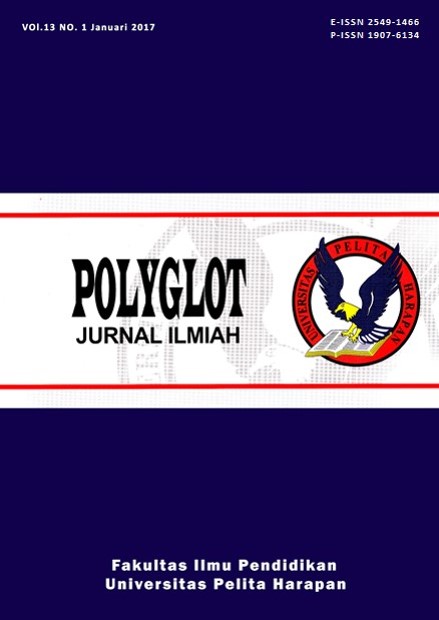Peran Guru Kristen sebagai Agen Restorasi dan Rekonsiliasi dalam Mengembangkan Karakter Kristus pada Diri Remaja sebagai Bagian dari Proses Pengudusan [The Role of Christian Educator as Agent of Restoration and Reconciliation in Developing Christ-like Character in Adolescence as part of the Sanctification Process]
DOI:
https://doi.org/10.19166/pji.v13i1.333Kata Kunci:
adolescents, Christ-like character, Christian teachers, sanctification, restoration, reconciliation, pengudusan, karakter Kristus, remaja, guru KristenAbstrak
Sanctification is a process of maturation to becoming more Christ-like in character after a person experiences regeneration. In the context of adolescent faith development, apart from parents and church clergy, regenerated adolescents also need support from Christian teachers as the agent of restoration in order to restore the image of God in themselves and as the agent of reconciliation in order to restore their relationship with God, others, and themselves all of which have been affected by sin. Christian teachers can function as role models for these adolescents both inside and outside classroom settings. One of the biggest barriers for adolescents to develop a more Christ-like character are their irrational beliefs that influence their thoughts and behaviors. This article will discuss the role of Christian teachers in helping adolescents to become more Christlike in character in their daily life.
BAHASA INDONESIA ABSTRAK: Pengudusan merupakan suatu proses pendewasaan menuju karakter Kristus setelah seseorang mengalami kelahiran baru. Dalam konteks perkembangan iman remaja, selain dari peran orangtua dan pendeta, para remaja yang telah lahir baru membutuhkan dukungan guru Kristen sebagai agen pemulihan untuk memulihkan gambar dan rupa Allah dalam diri mereka dan agen pendamaian untuk memulihkan relasi mereka dengan Allah, sesama, dan diri sendiri yang telah rusak karena dosa. Guru Kristen memiliki peran sebagai teladan bagi para remaja baik didalam maupun diluar konteks kelas. Salah satu hambatan terbesar bagi remaja untuk memiliki dan menghidupi karakter Kristus adalah irrational beliefs mereka yang mempengaruhi pikiran dan perilaku mereka. Artikel ini akan membahas bagaimana peran guru-guru Kristen dalam menolong para remaja untuk memiliki dan menghidupi karakter Kristus dalam kehidupan mereka sehari-hari.
Referensi
Collins, G. R. (2007). Christian counseling: A comprehensive guide (3rd ed.). Nashville: Thomas Nelson Publisher.
Corey, G. (2005). Theory and practice of counseling and psychotherapy. Australia: Thomson Brooks/Cole.
DiClemente, C. C. (2003). Addiction and change: How addiction develop and addicted people recover. New York: The Guilford Press.
Issler, K. (2012). Living into the life of Jesus: The formation of Christian character. Downers Grove, IL: Intervarsity.
Jones, S., & Butman, R. E. (Eds.). (1991). Modern psychotherapies. Downers Grove: InterVarsity.
Kirwan, W. T. (1984). Biblical concepts for Christian counseling: A case for integrating psychology and theology. Grand Rapids: Baker Book House.
Lewis, G. R., & Demarest, B. A. (1996). Integrative theology. Grand Rapids: Zondervan Publishing House
McDowell, J., & Hostetler, B. (1996). Handbook on counseling youth: A comprehensive guide for equipping youth workers, pastors, teachers, parents. Dallas: Word Publishing.
Minirth, F., Meier, P., & Arterburn, S. (1995). The complete life encyclopedia. Nashville: Thomas Nelson Publishers.
Parrot, III, L. (2000). Helping your struggling teenager: A parenting handbook on thirty-six common problems. Grand Rapids: Zondervan Publisihing House.
Susabda, Y. B. (2000). Pastoral konseling 1. Malang: Gandum Mas.
Van Brummelen, H. (1997). Walking with God in the classroom. Seattle: Alta Vista College Press.
Watson, D. L., & Tharp, R. G. (2004). Self-directed behavior: Self-modification for personal adjustment (10th ed.). Wadsworth: Cengage Learning.
Willard, D. (2002). Renovation of the heart. Colorado Springs: Navpress.
Unduhan
Diterbitkan
Terbitan
Bagian
Lisensi
Authors who publish with this journal agree to the following terms:
1) Authors retain copyright and grant the journal right of first publication with the work simultaneously licensed under a Creative Commons Attribution License (CC-BY-SA 4.0) that allows others to share the work with an acknowledgement of the work's authorship and initial publication in this journal.
2) Authors are able to enter into separate, additional contractual arrangements for the non-exclusive distribution of the journal's published version of the work (e.g., post it to an institutional repository or publish it in a book), with an acknowledgement of its initial publication in this journal.
3) Authors are permitted and encouraged to post their work online (e.g., in institutional repositories or on their website). The final published PDF should be used and bibliographic details that credit the publication in this journal should be included.





